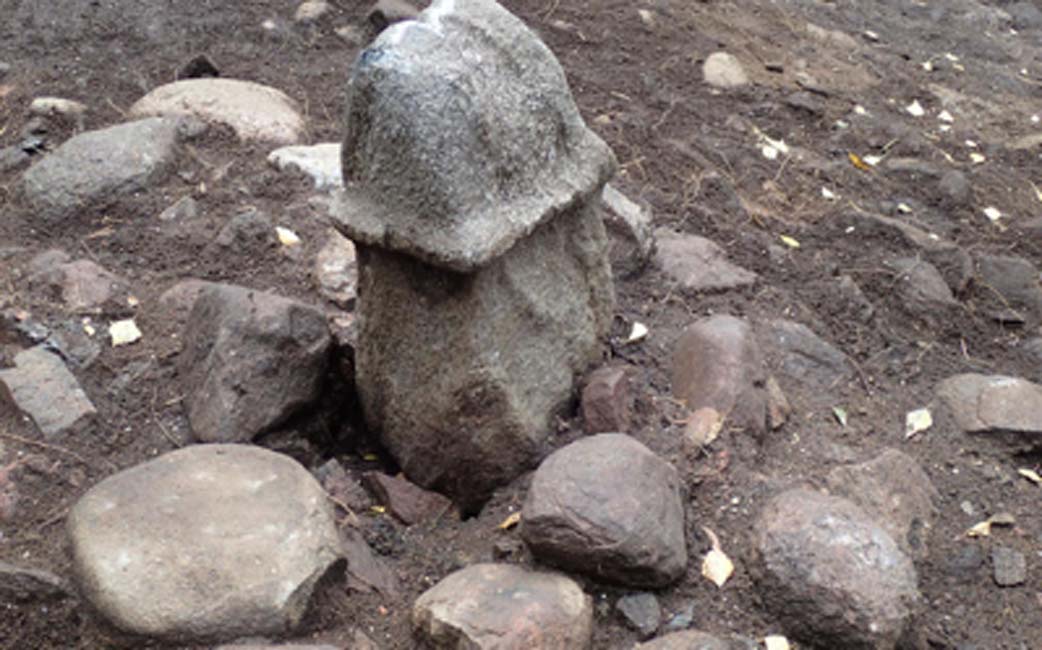Prehistoric Stone Penis Penetrates Through Time
A Bronze Age stone penis once used for sacrificial fertility rituals has been uncovered in Sweden. The carved phallic statue stands erect at nearly 2 feet (52 centimeters) high and has been linked to a Bronze Age fertility cult that existed between 1,800 and 500 BC.
This rare piece of ancient craftsmanship was accidentally discovered by archaeologists investigating a site listed for construction in Rollsbo, Sweden and archaeologist Gisela Ängeby, speaking to the Göteborgs-Posten, said the carved penis was initially thought to be a paving stone. It was only after the rocks were excavated the researchers saw something that “deviated from everything else” - a 2 foot (52 centimeter) long stone shaped like a penis.
It’s A Little Special
Ms. Ängeby said that in archaeological contexts one must be careful to call it a phallus but when she realized what it was she thought ”oh my god, it can’t be true”. Her colleagues quickly agreed that the stone has a very penis-like shape and because only two small animal bones were found beside it the stone is thought to have been “not” the center-piece of a burial site, but of a Bronze Age sacrificial site where animals may have been slaughtered within the rites of a “fertility cult,” said Ängeby.

Archaeologist Gisela Ängeby said that she was shocked when she stumbled across the stone phallus. Phallic stones aren't uncommon but it is rare to find one so closely modeled on the real thing. (The Archaeologists/NHM)
A report in The Local SE says the stone may have been weathered into its phallic-shape over the years and that the finished design we see today had been reinforced by people to look like a penis and Ms. Ängeby added that to find a standing stone in the middle of stone paving is not uncommon, but said this example is a “little special”.
Ancient Organs
For reasons that are quite obvious, in prehistory, the male member was the ultimate symbol of male fertility energy while breast and yoni shapes represented the female reproductive organs and feminine creation powers. And like today, many folk in history joked about their private sexual organs which were often not so private back then.
- Mushroom Monuments of Thrace and Ancient Sacred Rites
- Archaeologists unearth 18th Century Sex Toy in Ancient Latrine in Poland
- Pompeii fresco depicts hapless Priapus with a painful condition

The phallic stone was found erected in the center of the monument, with patches of soot surrounding it. (The Archaeologists/NHM)
This statement is grounded in a news piece I wrote for Ancient Origins last November about the discovery of rare 1,800 year-old floor mosaics in a men’s toilet in the coastal city of Antiochia ad Cragum in modern-day Turkey, an ancient city first established in the 1st century in the era of Emperor Nero.
Someone commissioned what archaeologists described as “rude twists” on famous myths, for example, one of the mosaics shows Narcissus fascinated with what a report in Live Science called his own “conspicuous phallus”.
However, if you want to get down and dirty and better understand the ritualization of male and female sexual organs, you really want to read Sex Symbols of the Ancient World: Top Ten Sexually Explicit Caves, Mountains, Temples and Artifacts. Sexuality was a way of the gods in ancient times and the recently discovered penis in Sweden is not as “rare” as the archaeologists might think, for all over the world before the written word, ancient societies extended their sexuality and sexual practices into the surrounding landscapes.
Fertility, The Gods’ Greatest Secret
Mountains, hills, rivers, waterfalls, caves, and rocks naturally shaped like penises, breasts, and vaginas were enhanced and perceived as highly-sacred places where prolonged sex rituals and sacrifices were often performed to assure successful harvests, animal breeding, the safe return of warriors and even to assure the daily return of the sun.
The ancient world is peppered with sexually explicit caves, mountains, rock formations, temples, arts and crafts which served as ancient gateways, or thresholds, into the magical realms of fertilization. Each ancient penis or vagina reveals a little more about how our forebears attempted to understand and harness their sexuality and the systems of birth and death they observed happening in nature.

The site where the stone penis was found under the stone-setting. (The Archaeologists/NHM)
Returning to Sweden’s 2 foot (52 centimeter) long stone penis, I can’t help but think that the arrangement of soft rounded stones around the penis are shaped like a yoni, deliberately, and what the archaeologists have discovered might be the penultimate symbol of ancient fertility, the male and female organs combined - the sexual act itself!
Top image: Monument of the stone penis, excavated in Rollsbo near Gothenburg in Sweden. Source: The Archaeologists/NHM.
By Ashley Cowie




















Comments
I always like how people tend to find deeper meaning in a protruding rock. It might have been fertility rituals and stuff, but maybe there where just 2 stoneage dudes thinking, hey that stone looks a bit like a penis, lets carve it up to look more like it. Why? cause it's fun. People have clearly laughed their asses of over genitalia for millenia.
4000....years...are people just stupid?
Circumsized phalic organs. 4000 years ago ?
God people are stupid.
Obviously ? Easily mislead so called archeologists....